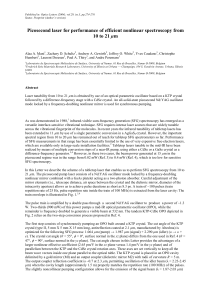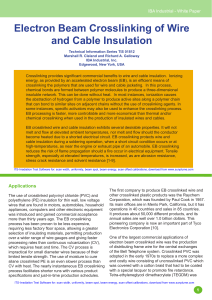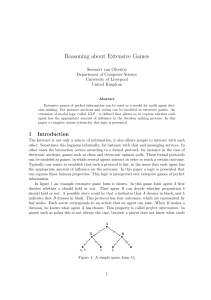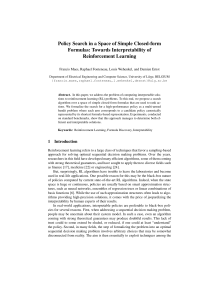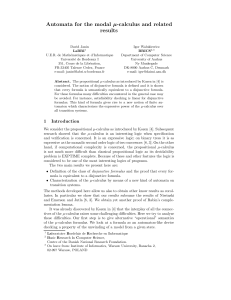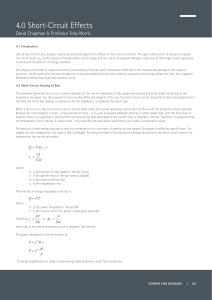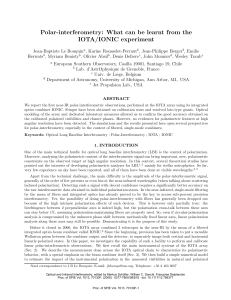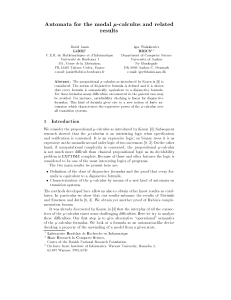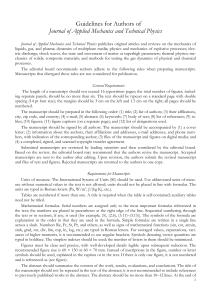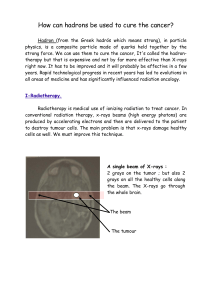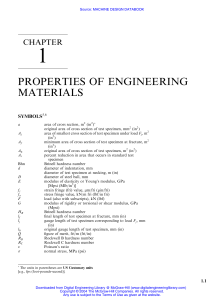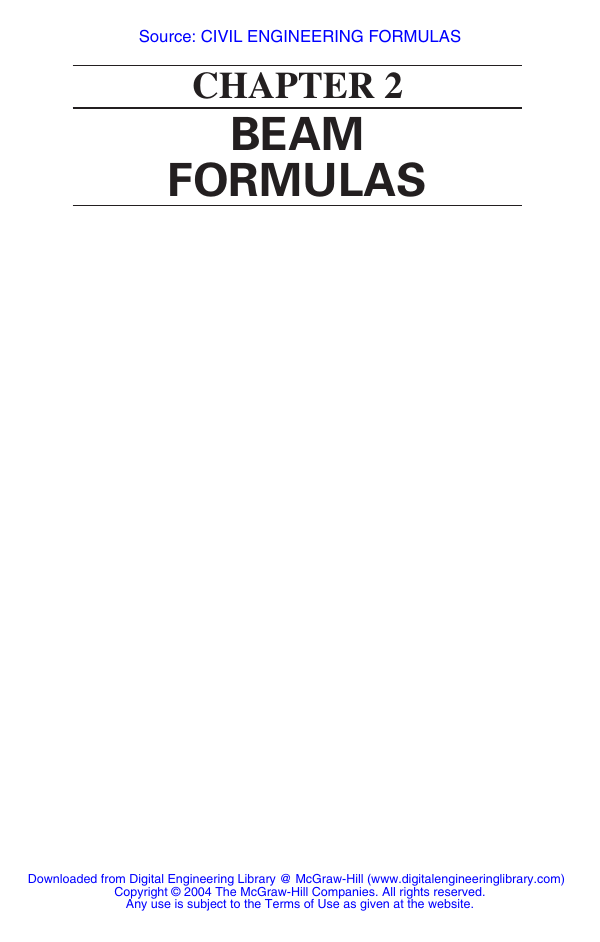
Source: CIVIL ENGINEERING FORMULAS CHAPTER 2 BEAM FORMULAS Downloaded from Digital Engineering Library @ McGraw-Hill (www.digitalengineeringlibrary.com) Copyright © 2004 The McGraw-Hill Companies. All rights reserved. Any use is subject to the Terms of Use as given at the website. BEAM FORMULAS 16 CHAPTER TWO In analyzing beams of various types, the geometric properties of a variety of cross-sectional areas are used. Figure 2.1 gives equations for computing area A, moment of inertia I, section modulus or the ratio S I/c, where c distance from the neutral axis to the outermost fiber of the beam or other member. Units used are inches and millimeters and their powers. The formulas in Fig. 2.1 are valid for both USCS and SI units. Handy formulas for some dozen different types of beams are given in Fig. 2.2. In Fig. 2.2, both USCS and SI units can be used in any of the formulas that are applicable to both steel and wooden beams. Note that W load, lb (kN); L length, ft (m); R reaction, lb (kN); V shear, lb (kN); M bending moment, lb ft (N m); D deflection, ft (m); a spacing, ft (m); b spacing, ft (m); E modulus of elasticity, lb/in2 (kPa); I moment of inertia, in4 (dm4); less than; greater than. Figure 2.3 gives the elastic-curve equations for a variety of prismatic beams. In these equations the load is given as P, lb (kN). Spacing is given as k, ft (m) and c, ft (m). CONTINUOUS BEAMS Continuous beams and frames are statically indeterminate. Bending moments in these beams are functions of the geometry, moments of inertia, loads, spans, and modulus of elasticity of individual members. Figure 2.4 shows how any span of a continuous beam can be treated as a single beam, with the moment diagram decomposed into basic components. Formulas for analysis are given in the diagram. Reactions of a continuous beam can be found by using the formulas in Fig. 2.5. Fixed-end moment formulas for beams of constant moment of inertia (prismatic beams) for Downloaded from Digital Engineering Library @ McGraw-Hill (www.digitalengineeringlibrary.com) Copyright © 2004 The McGraw-Hill Companies. All rights reserved. Any use is subject to the Terms of Use as given at the website. FIGURE 2.1 Geometric properties of sections. BEAM FORMULAS 17 Downloaded from Digital Engineering Library @ McGraw-Hill (www.digitalengineeringlibrary.com) Copyright © 2004 The McGraw-Hill Companies. All rights reserved. Any use is subject to the Terms of Use as given at the website. BEAM FORMULAS 18 Downloaded from Digital Engineering Library @ McGraw-Hill (www.digitalengineeringlibrary.com) Copyright © 2004 The McGraw-Hill Companies. All rights reserved. Any use is subject to the Terms of Use as given at the website. FIGURE 2.1 (Continued) Geometric properties of sections. BEAM FORMULAS 19 Downloaded from Digital Engineering Library @ McGraw-Hill (www.digitalengineeringlibrary.com) Copyright © 2004 The McGraw-Hill Companies. All rights reserved. Any use is subject to the Terms of Use as given at the website. BEAM FORMULAS 20 Downloaded from Digital Engineering Library @ McGraw-Hill (www.digitalengineeringlibrary.com) Copyright © 2004 The McGraw-Hill Companies. All rights reserved. Any use is subject to the Terms of Use as given at the website. FIGURE 2.1 (Continued) Geometric properties of sections. BEAM FORMULAS 21 Downloaded from Digital Engineering Library @ McGraw-Hill (www.digitalengineeringlibrary.com) Copyright © 2004 The McGraw-Hill Companies. All rights reserved. Any use is subject to the Terms of Use as given at the website. BEAM FORMULAS 22 Downloaded from Digital Engineering Library @ McGraw-Hill (www.digitalengineeringlibrary.com) Copyright © 2004 The McGraw-Hill Companies. All rights reserved. Any use is subject to the Terms of Use as given at the website. FIGURE 2.1 (Continued) Geometric properties of sections. BEAM FORMULAS 23 Downloaded from Digital Engineering Library @ McGraw-Hill (www.digitalengineeringlibrary.com) Copyright © 2004 The McGraw-Hill Companies. All rights reserved. Any use is subject to the Terms of Use as given at the website. BEAM FORMULAS 24 Downloaded from Digital Engineering Library @ McGraw-Hill (www.digitalengineeringlibrary.com) Copyright © 2004 The McGraw-Hill Companies. All rights reserved. Any use is subject to the Terms of Use as given at the website. FIGURE 2.1 (Continued) Geometric properties of sections. BEAM FORMULAS 25 Downloaded from Digital Engineering Library @ McGraw-Hill (www.digitalengineeringlibrary.com) Copyright © 2004 The McGraw-Hill Companies. All rights reserved. Any use is subject to the Terms of Use as given at the website. FIGURE 2.1 (Continued) Geometric properties of sections. BEAM FORMULAS 26 Downloaded from Digital Engineering Library @ McGraw-Hill (www.digitalengineeringlibrary.com) Copyright © 2004 The McGraw-Hill Companies. All rights reserved. Any use is subject to the Terms of Use as given at the website. BEAM FORMULAS 27 BEAM FORMULAS several common types of loading are given in Fig. 2.6. Curves (Fig. 2.7) can be used to speed computation of fixed-end moments in prismatic beams. Before the curves in Fig. 2.7 can be used, the characteristics of the loading must be computed by using the formulas in Fig. 2.8. These include xL, the location of the center of gravity of the loading with respect to one of the loads; G2 b 2n Pn/W, where bnL is the distance from each load Pn to the center of gravity of the loading (taken positive to the right); and S 3 b 3n Pn/W. These values are given in Fig. 2.8 for some common types of loading. Formulas for moments due to deflection of a fixed-end beam are given in Fig. 2.9. To use the modified moment distribution method for a fixed-end beam such as that in Fig. 2.9, we must first know the fixed-end moments for a beam with supports at different levels. In Fig. 2.9, the right end of a beam with span L is at a height d above the left end. To find the fixed-end moments, we first deflect the beam with both ends hinged; and then fix the right end, leaving the left end hinged, as in Fig. 2.9b. By noting that a line connecting the two supports makes an angle approximately equal to d/L (its tangent) with the original position of the beam, we apply a moment at the hinged end to produce an end rotation there equal to d/L. By the definition of stiffness, this moment equals that shown at the left end of Fig. 2.9b. The carryover to the right end is shown as the top formula on the right-hand side of Fig. 2.9b. By using the law of reciprocal deflections, we obtain the end moments of the deflected beam in Fig. 2.9 as M FL K FL (1 C FR) d L (2.1) M FR K FR (1 C FL ) d L (2.2) Downloaded from Digital Engineering Library @ McGraw-Hill (www.digitalengineeringlibrary.com) Copyright © 2004 The McGraw-Hill Companies. All rights reserved. Any use is subject to the Terms of Use as given at the website. BEAM FORMULAS 28 Downloaded from Digital Engineering Library @ McGraw-Hill (www.digitalengineeringlibrary.com) Copyright © 2004 The McGraw-Hill Companies. All rights reserved. Any use is subject to the Terms of Use as given at the website. FIGURE 2.2 Beam formulas. (From J. Callender, Time-Saver Standards for Architectural Design Data, 6th ed., McGraw-Hill, N.Y.) BEAM FORMULAS 29 Downloaded from Digital Engineering Library @ McGraw-Hill (www.digitalengineeringlibrary.com) Copyright © 2004 The McGraw-Hill Companies. All rights reserved. Any use is subject to the Terms of Use as given at the website. BEAM FORMULAS 30 Downloaded from Digital Engineering Library @ McGraw-Hill (www.digitalengineeringlibrary.com) Copyright © 2004 The McGraw-Hill Companies. All rights reserved. Any use is subject to the Terms of Use as given at the website. FIGURE 2.2 (Continued) Beam formulas. BEAM FORMULAS 31 Downloaded from Digital Engineering Library @ McGraw-Hill (www.digitalengineeringlibrary.com) Copyright © 2004 The McGraw-Hill Companies. All rights reserved. Any use is subject to the Terms of Use as given at the website. BEAM FORMULAS 32 Downloaded from Digital Engineering Library @ McGraw-Hill (www.digitalengineeringlibrary.com) Copyright © 2004 The McGraw-Hill Companies. All rights reserved. Any use is subject to the Terms of Use as given at the website. FIGURE 2.2 (Continued) Beam formulas. BEAM FORMULAS 33 Downloaded from Digital Engineering Library @ McGraw-Hill (www.digitalengineeringlibrary.com) Copyright © 2004 The McGraw-Hill Companies. All rights reserved. Any use is subject to the Terms of Use as given at the website. BEAM FORMULAS 34 Downloaded from Digital Engineering Library @ McGraw-Hill (www.digitalengineeringlibrary.com) Copyright © 2004 The McGraw-Hill Companies. All rights reserved. Any use is subject to the Terms of Use as given at the website. FIGURE 2.2 (Continued) Beam formulas. BEAM FORMULAS 35 Downloaded from Digital Engineering Library @ McGraw-Hill (www.digitalengineeringlibrary.com) Copyright © 2004 The McGraw-Hill Companies. All rights reserved. Any use is subject to the Terms of Use as given at the website. BEAM FORMULAS 36 Downloaded from Digital Engineering Library @ McGraw-Hill (www.digitalengineeringlibrary.com) Copyright © 2004 The McGraw-Hill Companies. All rights reserved. Any use is subject to the Terms of Use as given at the website. FIGURE 2.2 (Continued) Beam formulas. BEAM FORMULAS 37 Downloaded from Digital Engineering Library @ McGraw-Hill (www.digitalengineeringlibrary.com) Copyright © 2004 The McGraw-Hill Companies. All rights reserved. Any use is subject to the Terms of Use as given at the website. BEAM FORMULAS 38 Downloaded from Digital Engineering Library @ McGraw-Hill (www.digitalengineeringlibrary.com) Copyright © 2004 The McGraw-Hill Companies. All rights reserved. Any use is subject to the Terms of Use as given at the website. FIGURE 2.2 (Continued) Beam formulas. BEAM FORMULAS 39 Downloaded from Digital Engineering Library @ McGraw-Hill (www.digitalengineeringlibrary.com) Copyright © 2004 The McGraw-Hill Companies. All rights reserved. Any use is subject to the Terms of Use as given at the website. FIGURE 2.3 Elastic-curve equations for prismatic beams. (a) Shears, moments, deflections for full uniform load on a simply supported prismatic beam. (b) Shears and moments for uniform load over part of a simply supported prismatic beam. (c) Shears, moments, deflections for a concentrated load at any point of a simply supported prismatic beam. BEAM FORMULAS 40 Downloaded from Digital Engineering Library @ McGraw-Hill (www.digitalengineeringlibrary.com) Copyright © 2004 The McGraw-Hill Companies. All rights reserved. Any use is subject to the Terms of Use as given at the website. FIGURE 2.3 (Continued) Elastic-curve equations for prismatic beams. (d) Shears, moments, deflections for a concentrated load at midspan of a simply supported prismatic beam. (e) Shears, moments, deflections for two equal concentrated loads on a simply supported prismatic beam. ( f ) Shears, moments, deflections for several equal loads equally spaced on a simply supported prismatic beam. BEAM FORMULAS 41 Downloaded from Digital Engineering Library @ McGraw-Hill (www.digitalengineeringlibrary.com) Copyright © 2004 The McGraw-Hill Companies. All rights reserved. Any use is subject to the Terms of Use as given at the website. FIGURE 2.3 (Continued) Elastic-curve equations for prismatic beams. (g) Shears, moments, deflections for a concentrated load on a beam overhang. (h) Shears, moments, deflections for a concentrated load on the end of a prismatic cantilever. (i) Shears, moments, deflections for a uniform load over the full length of a beam with overhang. BEAM FORMULAS 42 Downloaded from Digital Engineering Library @ McGraw-Hill (www.digitalengineeringlibrary.com) Copyright © 2004 The McGraw-Hill Companies. All rights reserved. Any use is subject to the Terms of Use as given at the website. FIGURE 2.3 (Continued) Elastic-curve equations for prismatic beams. (j) Shears, moments, deflections for uniform load over the full length of a cantilever. (k) Shears, moments, deflections for uniform load on a beam overhang. (l) Shears, moments, deflections for triangular loading on a prismatic cantilever. BEAM FORMULAS 43 Downloaded from Digital Engineering Library @ McGraw-Hill (www.digitalengineeringlibrary.com) Copyright © 2004 The McGraw-Hill Companies. All rights reserved. Any use is subject to the Terms of Use as given at the website. FIGURE 2.3 (Continued) ing uniformly to one end. Elastic-curve equations for prismatic beams. (m) Simple beam—load increas- BEAM FORMULAS 44 Downloaded from Digital Engineering Library @ McGraw-Hill (www.digitalengineeringlibrary.com) Copyright © 2004 The McGraw-Hill Companies. All rights reserved. Any use is subject to the Terms of Use as given at the website. FIGURE 2.3 (Continued) Elastic-curve equations for prismatic beams. (n) Simple beam—load increasing uniformly to center. BEAM FORMULAS 45 Downloaded from Digital Engineering Library @ McGraw-Hill (www.digitalengineeringlibrary.com) Copyright © 2004 The McGraw-Hill Companies. All rights reserved. Any use is subject to the Terms of Use as given at the website. FIGURE 2.3 (Continued) Elastic-curve equations for prismatic beams. (o) Simple beam—uniform load partially distributed at one end. BEAM FORMULAS 46 Downloaded from Digital Engineering Library @ McGraw-Hill (www.digitalengineeringlibrary.com) Copyright © 2004 The McGraw-Hill Companies. All rights reserved. Any use is subject to the Terms of Use as given at the website. FIGURE 2.3 (Continued) trated load at free end. Elastic-curve equations for prismatic beams. (p) Cantilever beam—concen- BEAM FORMULAS 47 Downloaded from Digital Engineering Library @ McGraw-Hill (www.digitalengineeringlibrary.com) Copyright © 2004 The McGraw-Hill Companies. All rights reserved. Any use is subject to the Terms of Use as given at the website. FIGURE 2.3 (Continued) concentrated load at center. Elastic-curve equations for prismatic beams. (q) Beam fixed at both ends— BEAM FORMULAS 48 Downloaded from Digital Engineering Library @ McGraw-Hill (www.digitalengineeringlibrary.com) Copyright © 2004 The McGraw-Hill Companies. All rights reserved. Any use is subject to the Terms of Use as given at the website. FIGURE 2.4 Any span of a continuous beam (a) can be treated as a simple beam, as shown in (b) and (c). In (c), the moment diagram is decomposed into basic components. BEAM FORMULAS 49 Downloaded from Digital Engineering Library @ McGraw-Hill (www.digitalengineeringlibrary.com) Copyright © 2004 The McGraw-Hill Companies. All rights reserved. Any use is subject to the Terms of Use as given at the website. BEAM FORMULAS 50 CHAPTER TWO FIGURE 2.5 Reactions of continuous beam (a) found by making the beam statically determinate. (b) Deflections computed with interior supports removed. (c), (d), and (e) Deflections calculated for unit load over each removed support, to obtain equations for each redundant. Downloaded from Digital Engineering Library @ McGraw-Hill (www.digitalengineeringlibrary.com) Copyright © 2004 The McGraw-Hill Companies. All rights reserved. Any use is subject to the Terms of Use as given at the website. BEAM FORMULAS BEAM FORMULAS 51 FIGURE 2.6 Fixed-end moments for a prismatic beam. (a) For a concentrated load. (b) For a uniform load. (c) For two equal concentrated loads. (d) For three equal concentrated loads. In a similar manner the fixed-end moment for a beam with one end hinged and the supports at different levels can be found from MF K d L (2.3) where K is the actual stiffness for the end of the beam that is fixed; for beams of variable moment of inertia K equals the fixed-end stiffness times (1 C FL C FR). Downloaded from Digital Engineering Library @ McGraw-Hill (www.digitalengineeringlibrary.com) Copyright © 2004 The McGraw-Hill Companies. All rights reserved. Any use is subject to the Terms of Use as given at the website. BEAM FORMULAS FIGURE 2.7 loading. Chart for fixed-end moments due to any type of FIGURE 2.8 Characteristics of loadings. Downloaded from Digital Engineering Library @ McGraw-Hill (www.digitalengineeringlibrary.com) Copyright © 2004 The McGraw-Hill Companies. All rights reserved. Any use is subject to the Terms of Use as given at the website. BEAM FORMULAS BEAM FORMULAS FIGURE 2.8 (Continued) 53 Characteristics of loadings. ULTIMATE STRENGTH OF CONTINUOUS BEAMS Methods for computing the ultimate strength of continuous beams and frames may be based on two theorems that fix upper and lower limits for load-carrying capacity: 1. Upper-bound theorem. A load computed on the basis of an assumed link mechanism is always greater than, or at best equal to, the ultimate load. Downloaded from Digital Engineering Library @ McGraw-Hill (www.digitalengineeringlibrary.com) Copyright © 2004 The McGraw-Hill Companies. All rights reserved. Any use is subject to the Terms of Use as given at the website. BEAM FORMULAS 54 FIGURE 2.9 CHAPTER TWO Moments due to deflection of a fixed-end beam. 2. Lower-bound theorem. The load corresponding to an equilibrium condition with arbitrarily assumed values for the redundants is smaller than, or at best equal to, the ultimate loading—provided that everywhere moments do not exceed MP. The equilibrium method, based on the lower bound theorem, is usually easier for simple cases. Downloaded from Digital Engineering Library @ McGraw-Hill (www.digitalengineeringlibrary.com) Copyright © 2004 The McGraw-Hill Companies. All rights reserved. Any use is subject to the Terms of Use as given at the website. BEAM FORMULAS 55 BEAM FORMULAS For the continuous beam in Fig. 2.10, the ratio of the plastic moment for the end spans is k times that for the center span (k 1). Figure 2.10b shows the moment diagram for the beam made determinate by ignoring the moments at B and C and the moment diagram for end moments MB and MC applied to the determinate beam. Then, by using Fig. 2.10c, equilibrium is maintained when MP wL2 1 1 M M 4 2 B 2 C wL2 4 kM P wL2 4(1 k) (2.4) The mechanism method can be used to analyze rigid frames of constant section with fixed bases, as in Fig. 2.11. Using this method with the vertical load at midspan equal to 1.5 times the lateral load, the ultimate load for the frame is 4.8MP /L laterally and 7.2M P /L vertically at midspan. Maximum moment occurs in the interior spans AB and CD when x M L 2 wL (2.5) or if M kM P when x L kM P 2 wL (2.6) A plastic hinge forms at this point when the moment equals kMP. For equilibrium, Downloaded from Digital Engineering Library @ McGraw-Hill (www.digitalengineeringlibrary.com) Copyright © 2004 The McGraw-Hill Companies. All rights reserved. Any use is subject to the Terms of Use as given at the website. BEAM FORMULAS 56 CHAPTER TWO FIGURE 2.10 Continuous beam shown in (a) carries twice as much uniform load in the center span as in the side span. In (b) are shown the moment diagrams for this loading condition with redundants removed and for the redundants. The two moment diagrams are combined in (c), producing peaks at which plastic hinges are assumed to form. Downloaded from Digital Engineering Library @ McGraw-Hill (www.digitalengineeringlibrary.com) Copyright © 2004 The McGraw-Hill Companies. All rights reserved. Any use is subject to the Terms of Use as given at the website. FIGURE 2.11 Ultimate-load possibilities for a rigid frame of constant section with fixed bases. BEAM FORMULAS 57 Downloaded from Digital Engineering Library @ McGraw-Hill (www.digitalengineeringlibrary.com) Copyright © 2004 The McGraw-Hill Companies. All rights reserved. Any use is subject to the Terms of Use as given at the website. BEAM FORMULAS 58 CHAPTER TWO kM P w x x (L x) kM P 2 L w 2 kM 1 kM 冢 L2 kMwL 冣 冢 L2 KM wL 冣 冢 2 wL 冣 P P P 2 P leading to k 2M 2P wL2 3kM P 0 2 wL 4 (2.7) When the value of MP previously computed is substituted, 7k 2 4k 4 or k (k 4兾7) 4兾7 from which k 0.523. The ultimate load is wL 4M P (1 k) MP 6.1 L L (2.8) In any continuous beam, the bending moment at any section is equal to the bending moment at any other section, plus the shear at that section times its arm, plus the product of all the intervening external forces times their respective arms. Thus, in Fig. 2.12, Vx R 1 R 2 R 3 P1 P2 P3 M x R 1 (l 1 l 2 x) R 2 (l 2 x) R 3x P1 (l 2 c x) P2 (b x) P3a M x M 3 V3x P3a Table 2.1 gives the value of the moment at the various supports of a uniformly loaded continuous beam over equal Downloaded from Digital Engineering Library @ McGraw-Hill (www.digitalengineeringlibrary.com) Copyright © 2004 The McGraw-Hill Companies. All rights reserved. Any use is subject to the Terms of Use as given at the website. BEAM FORMULAS BEAM FORMULAS FIGURE 2.12 59 Continuous beam. spans, and it also gives the values of the shears on each side of the supports. Note that the shear is of the opposite sign on either side of the supports and that the sum of the two shears is equal to the reaction. Figure 2.13 shows the relation between the moment and shear diagrams for a uniformly loaded continuous beam of four equal spans. (See Table 2.1.) Table 2.1 also gives the maximum bending moment that occurs between supports, in addition to the position of this moment and the points of FIGURE 2.13 Relation between moment and shear diagrams for a uniformly loaded continuous beam of four equal spans. Downloaded from Digital Engineering Library @ McGraw-Hill (www.digitalengineeringlibrary.com) Copyright © 2004 The McGraw-Hill Companies. All rights reserved. Any use is subject to the Terms of Use as given at the website. Notation of support of span 1 or 2 1 2 1 2 1 2 3 1 Number of supports 2 3 4 5 0 兾10 0 兾10 兾10 11 兾28 兾28 兾28 15 兾38 0 兾10 0 兾28 兾28 0 13 17 6 4 13 15 5 兾28 兾28 0 2 3 1 0 3 1 0 1 兾8 0 5 兾8 0 兾8 5 兾8 Moment over each support 兾2 Shear on each side of support. L left, R right. Reaction at any support is L R L R (Uniform load per unit length w; length of each span l) 0.0364 0.0364 0.0779 0.080 0.025 0.0772 0.0703 0.0703 0.125 0.536 0.464 0.395 0.400 0.500 0.393 0.375 0.625 0.500 Distance to point of max moment, measured to Max right from moment in from each span support TABLE 2.1 Uniformly Loaded Continuous Beams over Equal Spans 0.266, 0.806 0.194, 0.734 0.789 0.800 0.276, 0.724 0.786 0.750 0.250 None Distance to point of inflection, measured to right from support BEAM FORMULAS 60 Downloaded from Digital Engineering Library @ McGraw-Hill (www.digitalengineeringlibrary.com) Copyright © 2004 The McGraw-Hill Companies. All rights reserved. Any use is subject to the Terms of Use as given at the website. 3 4 1 2 3 4 7 8 兾104 兾104 56 兾142 兾142 兾142 71 兾142 兾142 兾142 72 兾142 wl 67 86 53 49 wl 70 75 53 51 19 兾104 兾104 0 20 兾38 兾38 41 兾104 55 兾104 18 兾38 兾38 0 63 兾104 23 兾38 兾38 0 11 兾104 4 兾104 兾104 0 兾142 兾142 12 兾142 wl 2 11 15 9 8 3 wl 2 0.0338 0.0440 0.0405 0.0433 0.0433 0.0778 0.0332 0.0461 0.0777 0.0340 The numerical values given are coefficients of the expressions at the foot of each column. Values apply to 2 3 1 2 6 l 0.528 0.493 0.500 0.490 0.510 0.394 0.526 0.500 0.394 0.533 l 0.268, 0.788 0.196, 0.790 0.215, 0.785 0.196, 0.785 0.215, 0.804 0.789 0.268, 0.783 0.196, 0.804 0.788 0.268, 0.790 BEAM FORMULAS 61 Downloaded from Digital Engineering Library @ McGraw-Hill (www.digitalengineeringlibrary.com) Copyright © 2004 The McGraw-Hill Companies. All rights reserved. Any use is subject to the Terms of Use as given at the website. BEAM FORMULAS 62 CHAPTER TWO FIGURE 2.14 Values of the functions for a uniformly loaded continuous beam resting on three equal spans with four supports. inflection. Figure 2.14 shows the values of the functions for a uniformly loaded continuous beam resting on three equal spans with four supports. Maxwell’s Theorem When a number of loads rest upon a beam, the deflection at any point is equal to the sum of the deflections at this point due to each of the loads taken separately. Maxwell’s theorem states that if unit loads rest upon a beam at two points, A and B, the deflection at A due to the unit load at B equals the deflection at B due to the unit load at A. Castigliano’s Theorem This theorem states that the deflection of the point of application of an external force acting on a beam is equal Downloaded from Digital Engineering Library @ McGraw-Hill (www.digitalengineeringlibrary.com) Copyright © 2004 The McGraw-Hill Companies. All rights reserved. Any use is subject to the Terms of Use as given at the website. BEAM FORMULAS BEAM FORMULAS 63 to the partial derivative of the work of deformation with respect to this force. Thus, if P is the force, f is the deflection, and U is the work of deformation, which equals the resilience: dU f dP According to the principle of least work, the deformation of any structure takes place in such a manner that the work of deformation is a minimum. BEAMS OF UNIFORM STRENGTH Beams of uniform strength so vary in section that the unit stress S remains constant, and I/c varies as M. For rectangular beams of breadth b and depth d, I/c I/c bd 2/6 and M Sbd2/6. For a cantilever beam of rectangular cross section, under a load P, Px Sbd 2/6. If b is constant, d 2 varies with x, and the profile of the shape of the beam is a parabola, as in Fig. 2.15. If d is constant, b varies as x, and the beam is triangular in plan (Fig. 2.16). Shear at the end of a beam necessitates modification of the forms determined earlier. The area required to resist shear is P/Sv in a cantilever and R/Sv in a simple beam. Dotted extensions in Figs. 2.15 and 2.16 show the changes necessary to enable these cantilevers to resist shear. The waste in material and extra cost in fabricating, however, make many of the forms impractical, except for cast iron. Figure 2.17 shows some of the simple sections of uniform strength. In none of these, however, is shear taken into account. Downloaded from Digital Engineering Library @ McGraw-Hill (www.digitalengineeringlibrary.com) Copyright © 2004 The McGraw-Hill Companies. All rights reserved. Any use is subject to the Terms of Use as given at the website. BEAM FORMULAS 64 FIGURE 2.15 CHAPTER TWO Parabolic beam of uniform strength. SAFE LOADS FOR BEAMS OF VARIOUS TYPES Table 2.2 gives 32 formulas for computing the approximate safe loads on steel beams of various cross sections for an allowable stress of 16,000 lb/in2 (110.3 MPa). Use these formulas for quick estimation of the safe load for any steel beam you are using in a design. Downloaded from Digital Engineering Library @ McGraw-Hill (www.digitalengineeringlibrary.com) Copyright © 2004 The McGraw-Hill Companies. All rights reserved. Any use is subject to the Terms of Use as given at the website. BEAM FORMULAS BEAM FORMULAS FIGURE 2.16 65 Triangular beam of uniform strength. Table 2.3 gives coefficients for correcting values in Table 2.2 for various methods of support and loading. When combined with Table 2.2, the two sets of formulas provide useful time-saving means of making quick safeload computations in both the office and the field. Downloaded from Digital Engineering Library @ McGraw-Hill (www.digitalengineeringlibrary.com) Copyright © 2004 The McGraw-Hill Companies. All rights reserved. Any use is subject to the Terms of Use as given at the website. wL3 52(AD 2 ad 2) wL3 38AD 2 wL3 32(AD 2 ad 2) wL3 24AD 2 1,780AD L 1,780(AD ad) L 1,333AD L 1,333(AD ad) L 890AD L 890(AD ad) L 667AD L 667(AD ad) L Solid rectangle Hollow rectangle Solid cylinder Hollow cylinder wL3 24(AD 2 ad 2) wL3 38(AD 2 ad 2) wL3 52AD 2 3 wL 32AD 2 Load distributed Load in middle Load distributed Deflection, in‡ Load in middle Shape of section Greatest safe load, lb‡ (Beams supported at both ends; allowable fiber stress for steel, 16,000 lb/in2 (1.127 kgf/cm2) (basis of table) for iron, reduce values given in table by one-eighth) TABLE 2.2 Approximate Safe Loads in Pounds (kgf) on Steel Beams* BEAM FORMULAS 66 Downloaded from Digital Engineering Library @ McGraw-Hill (www.digitalengineeringlibrary.com) Copyright © 2004 The McGraw-Hill Companies. All rights reserved. Any use is subject to the Terms of Use as given at the website. wL3 85AD 2 wL3 80AD 2 wL3 93AD 2 wL3 53AD 2 wL3 50AD 2 wL3 58AD 2 3,050AD L 2,760AD L 3,390AD L 1,525AD L 1,380AD L 1,795AD L Channel or Z bar Deck beam I beam * L distance between supports, ft (m); A sectional area of beam, in2 (cm2); D depth of beam, in (cm); a interior area, in2 (cm2); d interior depth, in (cm); w total working load, net tons (kgf). wL3 52AD 2 wL3 32AD 2 1.770AD L 885AD L Even-legged angle or tee BEAM FORMULAS 67 Downloaded from Digital Engineering Library @ McGraw-Hill (www.digitalengineeringlibrary.com) Copyright © 2004 The McGraw-Hill Companies. All rights reserved. Any use is subject to the Terms of Use as given at the website. Beam supported at ends Load uniformly distributed over span Load concentrated at center of span Two equal loads symmetrically concentrated Load increasing uniformly to one end Load increasing uniformly to center Load decreasing uniformly to center Conditions of loading 1.0 1 兾2 l/4c 0.974 3 兾4 3 兾2 Max relative safe load TABLE 2.3 Coefficients for Correcting Values in Table 2.2 for Various Methods of Support and of Loading† 0.976 0.96 1.08 1.0 0.80 Max relative deflection under max relative safe load BEAM FORMULAS 68 Downloaded from Digital Engineering Library @ McGraw-Hill (www.digitalengineeringlibrary.com) Copyright © 2004 The McGraw-Hill Companies. All rights reserved. Any use is subject to the Terms of Use as given at the website. 兾4 兾8 3 兾8 l2/4a2 l/(l – 4a) 5.83 l/4a 1 1 2.40 3.20 1.92 † l length of beam; c distance from support to nearest concentrated load; a distance from support to end of beam. Beam continuous over two supports equidistant from ends Load uniformly distributed over span 1. If distance a 0.2071l 2. If distance a 0.2071l 3. If distance a 0.2071l Two equal loads concentrated at ends Beam fixed at one end, cantilever Load uniformly distributed over span Load concentrated at end Load increasing uniformly to fixed end BEAM FORMULAS 69 Downloaded from Digital Engineering Library @ McGraw-Hill (www.digitalengineeringlibrary.com) Copyright © 2004 The McGraw-Hill Companies. All rights reserved. Any use is subject to the Terms of Use as given at the website. BEAM FORMULAS 70 Downloaded from Digital Engineering Library @ McGraw-Hill (www.digitalengineeringlibrary.com) Copyright © 2004 The McGraw-Hill Companies. All rights reserved. Any use is subject to the Terms of Use as given at the website. FIGURE 2.17 Beams of uniform strength (in bending). BEAM FORMULAS 71 Downloaded from Digital Engineering Library @ McGraw-Hill (www.digitalengineeringlibrary.com) Copyright © 2004 The McGraw-Hill Companies. All rights reserved. Any use is subject to the Terms of Use as given at the website. BEAM FORMULAS 72 Downloaded from Digital Engineering Library @ McGraw-Hill (www.digitalengineeringlibrary.com) Copyright © 2004 The McGraw-Hill Companies. All rights reserved. Any use is subject to the Terms of Use as given at the website. FIGURE 2.17 (Continued) Beams of uniform strength (in bending). BEAM FORMULAS 73 Downloaded from Digital Engineering Library @ McGraw-Hill (www.digitalengineeringlibrary.com) Copyright © 2004 The McGraw-Hill Companies. All rights reserved. Any use is subject to the Terms of Use as given at the website. BEAM FORMULAS 74 Downloaded from Digital Engineering Library @ McGraw-Hill (www.digitalengineeringlibrary.com) Copyright © 2004 The McGraw-Hill Companies. All rights reserved. Any use is subject to the Terms of Use as given at the website. FIGURE 2.17 (Continued) Beams of uniform strength (in bending). BEAM FORMULAS 75 Downloaded from Digital Engineering Library @ McGraw-Hill (www.digitalengineeringlibrary.com) Copyright © 2004 The McGraw-Hill Companies. All rights reserved. Any use is subject to the Terms of Use as given at the website. BEAM FORMULAS 76 Downloaded from Digital Engineering Library @ McGraw-Hill (www.digitalengineeringlibrary.com) Copyright © 2004 The McGraw-Hill Companies. All rights reserved. Any use is subject to the Terms of Use as given at the website. FIGURE 2.17 (Continued) Beams of uniform strength (in bending). BEAM FORMULAS 77 Downloaded from Digital Engineering Library @ McGraw-Hill (www.digitalengineeringlibrary.com) Copyright © 2004 The McGraw-Hill Companies. All rights reserved. Any use is subject to the Terms of Use as given at the website. FIGURE 2.17 (Continued) Beams of uniform strength (in bending). BEAM FORMULAS 78 Downloaded from Digital Engineering Library @ McGraw-Hill (www.digitalengineeringlibrary.com) Copyright © 2004 The McGraw-Hill Companies. All rights reserved. Any use is subject to the Terms of Use as given at the website. BEAM FORMULAS 79 BEAM FORMULAS ROLLING AND MOVING LOADS Rolling and moving loads are loads that may change their position on a beam or beams. Figure 2.18 shows a beam with two equal concentrated moving loads, such as two wheels on a crane girder, or the wheels of a truck on a bridge. Because the maximum moment occurs where the shear is zero, the shear diagram shows that the maximum moment occurs under a wheel. Thus, with x a/2: 冢 R1 P 1 M2 冣 冢 冣 Pl a 2x a 4x 2 1 2 2 l l l l 冢 R2 P 1 M1 2x a l l Pl 2 2x a l l 冣 冢1 al 2al 2 2 2x 3a 4x 2 2 l l l 冣 M2 max when x 1兾4a M1 max when x 3兾4a M max Pl 2 冢 1 a 2l 冣 2 P 2l 冢 l a 2 冣 2 Figure 2.19 shows the condition when two equal loads are equally distant on opposite sides of the center of the beam. The moment is then equal under the two loads. Downloaded from Digital Engineering Library @ McGraw-Hill (www.digitalengineeringlibrary.com) Copyright © 2004 The McGraw-Hill Companies. All rights reserved. Any use is subject to the Terms of Use as given at the website. BEAM FORMULAS FIGURE 2.18 Two equal concentrated moving loads. FIGURE 2.19 Two equal moving loads equally distant on opposite sides of the center. 80 Downloaded from Digital Engineering Library @ McGraw-Hill (www.digitalengineeringlibrary.com) Copyright © 2004 The McGraw-Hill Companies. All rights reserved. Any use is subject to the Terms of Use as given at the website. BEAM FORMULAS BEAM FORMULAS 81 If two moving loads are of unequal weight, the condition for maximum moment is the maximum moment occurring under the heavier wheel when the center of the beam bisects the distance between the resultant of the loads and the heavier wheel. Figure 2.20 shows this position and the shear and moment diagrams. When several wheel loads constituting a system are on a beam or beams, the several wheels must be examined in turn to determine which causes the greatest moment. The position for the greatest moment that can occur under a given FIGURE 2.20 Two moving loads of unequal weight. Downloaded from Digital Engineering Library @ McGraw-Hill (www.digitalengineeringlibrary.com) Copyright © 2004 The McGraw-Hill Companies. All rights reserved. Any use is subject to the Terms of Use as given at the website. BEAM FORMULAS 82 CHAPTER TWO wheel is, as stated earlier, when the center of the span bisects the distance between the wheel in question and the resultant of all loads then on the span. The position for maximum shear at the support is when one wheel is passing off the span. CURVED BEAMS The application of the flexure formula for a straight beam to the case of a curved beam results in error. When all “fibers” of a member have the same center of curvature, the concentric or common type of curved beam exists (Fig. 2.21). Such a beam is defined by the Winkler–Bach theory. The stress at a point y units from the centroidal axis is S M AR 冤1 Z (Ry y) 冥 M is the bending moment, positive when it increases curvature; y is positive when measured toward the convex side; A is the cross-sectional area; R is the radius of the centroidal axis; Z is a cross-section property defined by Z 1 A 冕 y dA Ry Analytical expressions for Z of certain sections are given in Table 2.4. Z can also be found by graphical integration methods (see any advanced strength book). The neutral surface shifts toward the center of curvature, or inside fiber, an amount equal to e ZR/(Z 1). The Winkler–Bach Downloaded from Digital Engineering Library @ McGraw-Hill (www.digitalengineeringlibrary.com) Copyright © 2004 The McGraw-Hill Companies. All rights reserved. Any use is subject to the Terms of Use as given at the website. Section 冢ln RR CC 冣 2 Expression Z 1 R R C2 b ln A R C2 A 2 [(t b)C1 bC2] 冤 冢 Z 1 1 1 冣 (t b) ln 冢 RR CC 冣 冥 R t ln (R C1) (b t) ln (R C0) b ln (R C2) A and A tC1 (b t) C3 bC2 冤 冢 Rr 冣 冤 Rr √冢 Rr 冣 1 冥 R h Z 1 2 Z 1 TABLE 2.4 Analytical Expressions for Z 冥 BEAM FORMULAS 83 Downloaded from Digital Engineering Library @ McGraw-Hill (www.digitalengineeringlibrary.com) Copyright © 2004 The McGraw-Hill Companies. All rights reserved. Any use is subject to the Terms of Use as given at the website. BEAM FORMULAS 84 FIGURE 2.21 CHAPTER TWO Curved beam. theory, though practically satisfactory, disregards radial stresses as well as lateral deformations and assumes pure bending. The maximum stress occurring on the inside fiber is S Mhi /AeRi, whereas that on the outside fiber is S Mh0 /AeR0. The deflection in curved beams can be computed by means of the moment-area theory. The resultant deflection is then equal to 0 √ 2x 2y in the direction defined by tan y / x. Deflections can also be found conveniently by use of Castigliano’s theorem. It states that in an elastic system the displacement in the direction of a force (or couple) and due to that force (or couple) is the partial derivative of the strain energy with respect to the force (or couple). A quadrant of radius R is fixed at one end as shown in Fig. 2.22. The force F is applied in the radial direction at free-end B. Then, the deflection of B is Downloaded from Digital Engineering Library @ McGraw-Hill (www.digitalengineeringlibrary.com) Copyright © 2004 The McGraw-Hill Companies. All rights reserved. Any use is subject to the Terms of Use as given at the website. BEAM FORMULAS 85 BEAM FORMULAS By moment area, y R sin x R(1 cos ) ds Rd M FR sin B x and FR 3 4EI B FR3 2EI B √ 冢 tan 1 FR 3 2EI 2 1 x tan 1 at y 4 FR 3 2EI 4EI FR 3 冣 2 32.5 By Castigliano, B FIGURE 2.22 x FR3 4EI B y FR3 2EI Quadrant with fixed end. Downloaded from Digital Engineering Library @ McGraw-Hill (www.digitalengineeringlibrary.com) Copyright © 2004 The McGraw-Hill Companies. All rights reserved. Any use is subject to the Terms of Use as given at the website. BEAM FORMULAS 86 CHAPTER TWO Eccentrically Curved Beams These beams (Fig. 2.23) are bounded by arcs having different centers of curvature. In addition, it is possible for either radius to be the larger one. The one in which the section depth shortens as the central section is approached may be called the arch beam. When the central section is the largest, the beam is of the crescent type. Crescent I denotes the beam of larger outside radius and crescent II of larger inside radius. The stress at the central section of such beams may be found from S KMC/I. In the case of rectangular cross section, the equation becomes S 6KM/bh2, where M is the bending moment, b is the width of the beam section, and h its height. The stress factors, K for the inner boundary, established from photoelastic data, are given in Table 2.5. The outside radius FIGURE 2.23 Eccentrically curved beams. Downloaded from Digital Engineering Library @ McGraw-Hill (www.digitalengineeringlibrary.com) Copyright © 2004 The McGraw-Hill Companies. All rights reserved. Any use is subject to the Terms of Use as given at the website. BEAM FORMULAS 87 BEAM FORMULAS TABLE 2.5 Stress Factors for Inner Boundary at Central Section (see Fig. 2.23) 1. For the arch-type beams h Ro Ri (a) K 0.834 1.504 if Ro Ri 5 h h Ro Ri 10 if 5 Ro Ri h (c) In the case of larger section ratios use the equivalent beam solution (b) K 0.899 1.181 2. For the crescent I-type beams (a) K 0.570 1.536 h Ro Ri if Ro Ri 2 h (b) K 0.959 0.769 h Ro Ri if 2 (c) K 1.092 冢 R h R 冣 Ro Ri 20 h 0.0298 o Ro Ri 20 h if i 3. For the crescent II-type beams h Ro Ri (a) K 0.897 1.098 (b) K 1.119 Ro Ri 8 h 冢 R h R 冣 if 8 冢 R h R 冣 if Ro Ri 20 h 0.0378 o (c) K 1.081 if i 0.0270 o i Ro Ri 20 h is denoted by Ro and the inside by Ri. The geometry of crescent beams is such that the stress can be larger in offcenter sections. The stress at the central section determined above must then be multiplied by the position factor k, Downloaded from Digital Engineering Library @ McGraw-Hill (www.digitalengineeringlibrary.com) Copyright © 2004 The McGraw-Hill Companies. All rights reserved. Any use is subject to the Terms of Use as given at the website. BEAM FORMULAS 88 CHAPTER TWO given in Table 2.6. As in the concentric beam, the neutral surface shifts slightly toward the inner boundary. (See Vidosic, “Curved Beams with Eccentric Boundaries,” Transactions of the ASME, 79, pp. 1317–1321.) ELASTIC LATERAL BUCKLING OF BEAMS When lateral buckling of a beam occurs, the beam undergoes a combination of twist and out-of-plane bending (Fig. 2.24). For a simply supported beam of rectangular cross section subjected to uniform bending, buckling occurs at the critical bending moment, given by Mcr where L √EIyGJ L unbraced length of the member E modulus of elasticity Iy moment of inertial about minor axis G shear modulus of elasticity J torsional constant The critical moment is proportional to both the lateral bending stiffness EIy /L and the torsional stiffness of the member GJ/L. For the case of an open section, such as a wide-flange or I-beam section, warping rigidity can provide additional torsional stiffness. Buckling of a simply supported beam of open cross section subjected to uniform bending occurs at the critical bending moment, given by Downloaded from Digital Engineering Library @ McGraw-Hill (www.digitalengineeringlibrary.com) Copyright © 2004 The McGraw-Hill Companies. All rights reserved. Any use is subject to the Terms of Use as given at the website. BEAM FORMULAS 89 BEAM FORMULAS Mcr L √ 冢 EIy GJ ECw 2 L 2 where Cw is the warping constant, a function of crosssectional shape and dimensions (Fig. 2.25). In the preceding equations, the distribution of bending moment is assumed to be uniform. For the case of a nonuniform bending-moment gradient, buckling often occurs at TABLE 2.6 Crescent-Beam Position Stress Factors (see Fig. 2.23)† Angle , degree 10 20 30 40 50 60 70 80 90 k Inner 1 0.055 H/h 1 0.164 H/h 1 0.365 H / h 1 0.567 H / h (0.5171 1.382 H/h)1/2 1.521 1.382 (0.2416 0.6506 H/h)1/2 1.756 0.6506 (0.4817 1.298 H/h)1/2 2.070 0.6492 (0.2939 0.7084 H/h)1/2 2.531 0.3542 Outer 1 0.03 H/h 1 0.10 H/h 1 0.25 H/h 1 0.467 H/h 1 0.733 H/h 1 1.123 H/h 1 1.70 H/h 1 2.383 H/h 1 3.933 H/h Note: All formulas are valid for 0 H/h 0.325. Formulas for the inner boundary, except for 40 degrees, may be used to H/h 0.36. H distance between centers. † Downloaded from Digital Engineering Library @ McGraw-Hill (www.digitalengineeringlibrary.com) Copyright © 2004 The McGraw-Hill Companies. All rights reserved. Any use is subject to the Terms of Use as given at the website. BEAM FORMULAS 90 CHAPTER TWO FIGURE 2.24 (a) Simple beam subjected to equal end moments. (b) Elastic lateral buckling of the beam. a larger critical moment. Approximation of this critical bending moment, Mcr may be obtained by multiplying Mcr given by the previous equations by an amplification factor M cr Cb Mcr where Cb 12.5Mmax 2.5Mmax 3MA 4MB 3MC Downloaded from Digital Engineering Library @ McGraw-Hill (www.digitalengineeringlibrary.com) Copyright © 2004 The McGraw-Hill Companies. All rights reserved. Any use is subject to the Terms of Use as given at the website. BEAM FORMULAS BEAM FORMULAS 91 FIGURE 2.25 Torsion-bending constants for torsional buckling. A cross-sectional area; Ix moment of inertia about x–x axis; Iy moment of inertia about y–y axis. (After McGraw-Hill, New York). Bleich, F., Buckling Strength of Metal Structures. and Mmax absolute value of maximum moment in the unbraced beam segment MA absolute value of moment at quarter point of the unbraced beam segment MB absolute value of moment at centerline of the unbraced beam segment MC absolute value of moment at three-quarter point of the unbraced beam segment Downloaded from Digital Engineering Library @ McGraw-Hill (www.digitalengineeringlibrary.com) Copyright © 2004 The McGraw-Hill Companies. All rights reserved. Any use is subject to the Terms of Use as given at the website. BEAM FORMULAS 92 CHAPTER TWO Cb equals 1.0 for unbraced cantilevers and for members where the moment within a significant portion of the unbraced segment is greater than, or equal to, the larger of the segment end moments. COMBINED AXIAL AND BENDING LOADS For short beams, subjected to both transverse and axial loads, the stresses are given by the principle of superposition if the deflection due to bending may be neglected without serious error. That is, the total stress is given with sufficient accuracy at any section by the sum of the axial stress and the bending stresses. The maximum stress, lb/in2 (MPa), equals f P Mc A I where P axial load, lb (N ) A cross-sectional area, in2 (mm2) M maximum bending moment, in lb (Nm) c distance from neutral axis to outermost fiber at the section where maximum moment occurs, in (mm) I moment of inertia about neutral axis at that section, in4 (mm4) When the deflection due to bending is large and the axial load produces bending stresses that cannot be neglected, the maximum stress is given by Downloaded from Digital Engineering Library @ McGraw-Hill (www.digitalengineeringlibrary.com) Copyright © 2004 The McGraw-Hill Companies. All rights reserved. Any use is subject to the Terms of Use as given at the website. BEAM FORMULAS BEAM FORMULAS f 93 P c (M Pd) A I where d is the deflection of the beam. For axial compression, the moment Pd should be given the same sign as M; and for tension, the opposite sign, but the minimum value of M Pd is zero. The deflection d for axial compression and bending can be closely approximated by d do 1 (P/Pc) where do deflection for the transverse loading alone, in (mm); and Pc critical buckling load 2EI / L2, lb (N). UNSYMMETRICAL BENDING When a beam is subjected to loads that do not lie in a plane containing a principal axis of each cross section, unsymmetrical bending occurs. Assuming that the bending axis of the beam lies in the plane of the loads, to preclude torsion, and that the loads are perpendicular to the bending axis, to preclude axial components, the stress, lb/in2 (MPa), at any point in a cross section is f where M x Mx y y Ix Iy Mx bending moment about principal axis XX, in lb (Nm) My bending moment about principal axis YY, in lb (Nm) Downloaded from Digital Engineering Library @ McGraw-Hill (www.digitalengineeringlibrary.com) Copyright © 2004 The McGraw-Hill Companies. All rights reserved. Any use is subject to the Terms of Use as given at the website. BEAM FORMULAS 94 CHAPTER TWO x distance from point where stress is to be computed to YY axis, in (mm) y distance from point to XX axis, in (mm) Ix moment of inertia of cross section about XX, in (mm4) Iy moment of inertia about YY, in (mm4) If the plane of the loads makes an angle with a principal plane, the neutral surface forms an angle with the other principal plane such that tan Ix tan Iy ECCENTRIC LOADING If an eccentric longitudinal load is applied to a bar in the plane of symmetry, it produces a bending moment Pe, where e is the distance, in (mm), of the load P from the centroidal axis. The total unit stress is the sum of this moment and the stress due to P applied as an axial load: f P Pec P A I A 冢1 ecr 冣 2 where A cross-sectional area, in2 (mm2) c distance from neutral axis to outermost fiber, in (mm) Downloaded from Digital Engineering Library @ McGraw-Hill (www.digitalengineeringlibrary.com) Copyright © 2004 The McGraw-Hill Companies. All rights reserved. Any use is subject to the Terms of Use as given at the website. BEAM FORMULAS BEAM FORMULAS 95 I moment of inertia of cross section about neutral axis, in4 (mm4) r radius of gyration √I/A, in (mm) Figure 2.1 gives values of the radius of gyration for several cross sections. If there is to be no tension on the cross section under a compressive load, e should not exceed r 2/c. For a rectangular section with width b, and depth d, the eccentricity, therefore, should be less than b/6 and d/6 (i.e., the load should not be applied outside the middle third). For a circular cross section with diameter D, the eccentricity should not exceed D/8. When the eccentric longitudinal load produces a deflection too large to be neglected in computing the bending stress, account must be taken of the additional bending moment Pd, where d is the deflection, in (mm). This deflection may be closely approximated by d 4eP/Pc (1 P/Pc) Pc is the critical buckling load 2EI/L2, lb (N). If the load P, does not lie in a plane containing an axis of symmetry, it produces bending about the two principal axes through the centroid of the section. The stresses, lb/in2 (MPa), are given by f Pexcx Peycy P A Iy Ix where A cross-sectional area, in2 (mm2) ex eccentricity with respect to principal axis YY, in (mm) Downloaded from Digital Engineering Library @ McGraw-Hill (www.digitalengineeringlibrary.com) Copyright © 2004 The McGraw-Hill Companies. All rights reserved. Any use is subject to the Terms of Use as given at the website. BEAM FORMULAS 96 CHAPTER TWO ey eccentricity with respect to principal axis XX, in (mm) cx distance from YY to outermost fiber, in (mm) cy distance from XX to outermost fiber, in (mm) Ix moment of inertia about XX, in4 (mm4) Iy moment of inertia about YY, in4 (mm4) The principal axes are the two perpendicular axes through the centroid for which the moments of inertia are a maximum or a minimum and for which the products of inertia are zero. NATURAL CIRCULAR FREQUENCIES AND NATURAL PERIODS OF VIBRATION OF PRISMATIC BEAMS Figure 2.26 shows the characteristic shape and gives constants for determination of natural circular frequency and natural period T, for the first four modes of cantilever, simply supported, fixed-end, and fixed-hinged beams. To obtain , select the appropriate constant from Fig. 2.26 and multiply it by √EI/wL4. To get T, divide the appropriate constant by √EI/wL4. In these equations, natural frequency, rad/s W beam weight, lb per linear ft (kg per linear m) L beam length, ft (m) Downloaded from Digital Engineering Library @ McGraw-Hill (www.digitalengineeringlibrary.com) Copyright © 2004 The McGraw-Hill Companies. All rights reserved. Any use is subject to the Terms of Use as given at the website. FIGURE 2.26 Coefficients for computing natural circular frequencies and natural periods of vibration of prismatic beams. BEAM FORMULAS 97 Downloaded from Digital Engineering Library @ McGraw-Hill (www.digitalengineeringlibrary.com) Copyright © 2004 The McGraw-Hill Companies. All rights reserved. Any use is subject to the Terms of Use as given at the website. BEAM FORMULAS 98 CHAPTER TWO E modulus of elasticity, lb/in2 (MPa) I moment of inertia of beam cross section, in4 (mm4) T natural period, s To determine the characteristic shapes and natural periods for beams with variable cross section and mass, use the Rayleigh method. Convert the beam into a lumped-mass system by dividing the span into elements and assuming the mass of each element to be concentrated at its center. Also, compute all quantities, such as deflection and bending moment, at the center of each element. Start with an assumed characteristic shape. ] Downloaded from Digital Engineering Library @ McGraw-Hill (www.digitalengineeringlibrary.com) Copyright © 2004 The McGraw-Hill Companies. All rights reserved. Any use is subject to the Terms of Use as given at the website.



